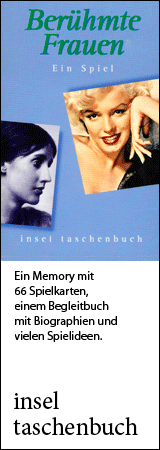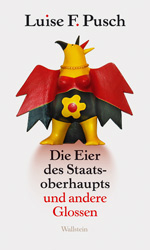
Wikimedia Commons
born on June 6, 1950 in Brussels, Belgium
died on October 5, 2015 in Paris, France
Belgian film director, actress and video artist
75th birthday on June 6, 2025
10th anniversary of her death on October 5, 2025
Biography
Chantal Akerman was just 18 years old in 1968 when the first film she made caused a sensation at the Oberhausen Short Film Festival.
Shot in her own apartment, Saute ma Ville (Blow Up My Town) shows a young woman (played by herself) who tries, in a slapstick-like performance over 13 minutes, to create order among her things and yet only ever produces more chaos. In the end, she blows herself and her kitchen up when the gas stove is turned on. This debut work already contained several elements characteristic of her life's work: a penchant for the tragicomic, an analysis of women’s confinement, the processing of personal life experience as well as of family memories that were not discussed.
Chantal Akerman grew up in a family of assimilated Jewish immigrants of Polish descent. Her parents, who ran a small leather goods shop in Brussels, were Holocaust survivors, but they never spoke about their traumatic experiences. Her mother's “noisy silence” (which she only broke for the first time at an advanced age) became, as Akerman herself noted, one of the main driving forces behind her cinematic research, her reflection on her own Jewish identity, and her preoccupation with loss, homelessness, and uprooting.
Akerman dropped out of school at 17 to attend a Belgian film academy for a few months. She studied briefly at a drama college in Paris and worked on a kibbutz in Israel before arriving in New York City in the early 70s where she immersed herself in the film-making world of the American avant-garde. With little financial means and much support from fellow artists, including cinematographer Babette Mangolte, she shot her first feature-length films in the years that followed. These included Hotel Monterey, an experimental documentary about a New York homeless shelter and Je tu il elle, a 90-minute feature film about a young woman's bold self-exploration. The love scene between Akerman and her film partner Claire Wauthion, shown in detail in the final third of the film, makes it a milestone in the history of lesbian film-making.
Over a period of two months in 1974 she shot the film that is considered her masterpiece. With an almost all-female crew and starring the well-known French actress Delphine Seyrig, Jeanne Dielman, 23 Quai du Commerce, 1080 Bruxelles depicts three days in the life of a widowed homemaker in Belgium – the single mother of a teenage son who is a part-time prostitute to make ends meet. The film, which is over three hours long, uses long takes and repeats static shots to show the woman in a meticulously organized daily routine of cleaning, cooking, and having dinner with her son with the same controlled precision as it shows her attending to the men who pay her for sex. On the third day, cracks appear in the routine: the protagonist makes some small mistakes, experiences an obviously unwanted orgasm, and stabs the client to death with a pair of scissors from her dressing table. Presented at Cannes in 1975, the film was celebrated as “undoubtedly the first masterpiece of the feminine in the history of cinema” due to its radical content and form. Akerman herself found the idea of a feminist film language restrictive: “when people say there is a feminist film language, it is like saying there is only one way for women to express themselves.” She believed that “there should be as many different ways of expression as there are different women making films.”
Jeanne Dielman was enormously successful and made her the shooting star of a new European auteur cinema at the age of 25. Over the following decades, she continued her search for her own cinematic language across many different genres. This included works with strong autobiographical elements (e.g., News from Home, 1976, which combines shots of New York street scenes with softly read excerpts from letters full of loving concern that her mother wrote to her rebellious daughter in faraway America); subtle critiques of the American musical tradition (e.g. Golden Eighties, 1988, about the romantic entanglements of “working girls” in a Brussels shopping center with song and dance interludes); literary film adaptations (including The Captive, 2000, based on a chapter of a novel by Marcel Proust that was considered unfilmable, with the magnificent Sylvie Testud in the female lead, an oppressive chamber piece about jealousy, obsession, the impossibility of love); and, beginning in the 1990s, a series of impressive documentaries about racial conflicts in the southern United States, illegal border crossings into the U.S. from Mexico, and Eastern Europe after the fall of the Berlin Wall with visual allusions to deportation, the Holocaust, and the Soviet gulag. These documentaries consist of impressions and chance encounters shot in the long takes – her “trademark” – that she considered essential to making “the invisible visible” for viewers.
Her films were widely acclaimed by critics and served as a source of inspiration for other directors (e.g. Gus van Sant). Yet as they were generally regarded as difficult and not suitable for the masses, they were typically only shown in small arthouse cinemas and at festivals (e.g. in a major retrospective at the Centre Pompidou in Paris in 2004). Her attempt to appeal to a wider audience – the romantic comedy A Couch in New York, 1996, starring Juliette Binoche and William Hurt – was a huge disappointment and flopped at the box office. Akerman fans felt it wasn't “Akerman” enough, while others didn't bother to go.
From early on, Akerman tried to cross boundaries in her work – the boundary between fiction and documentary in her films and the boundary between film and visual art in her video installations. Of particular personal significance was an installation from 2004 with text excerpts from the diary of her grandmother, who was murdered in Auschwitz, and clips from a conversation with her mother, who then for the first time alluded to her own concentration camp experiences and talked about the support of her friend Frieda that had been essential for her survival. Ten years later, shortly before her mother's death at the age of 86, Akerman dedicated an extensive film portrait to her, titled No Home Movie. Natalia Akerman died in April 2014, before the film was completed. Chantal Akerman was deeply affected by the loss: “I wonder what I have left to say now that my mother is no longer here.” Neither her network of close friends and collaborators, such as her congenial editor Claire Atherton, nor the love of her partner Sonia Wieder-Atherton, an exceptional cellist who had provided the musical accompaniment to many of her films, could keep her alive. The depression from which she had long suffered prevailed: at the age of just 65, Chantal Akerman took her own life in Paris in October 2015.
(Text from 2019; translated with DeepL.com; edited by Ramona Fararo, 2025.
Please consult the German version for additional information, pictures, sources, videos, and bibliography.)
Author: Andrea Schweers
Quotes
I made art out of a woman washing the dishes. (about the film Jeanne Dielman)
I don't make women's films, I make Chantal Akerman films.
There are good directors, there are great directors, there are filmmakers who have their place in the history of cinema, and then there are the rare filmmakers who change the history of film. (Nicola Mazzanti, director of the Royal Belgian Film Archive, on Chantal Akerman)
If you hold the rights to one or more of the images on this page and object to its/their appearance here, please contact Fembio.



